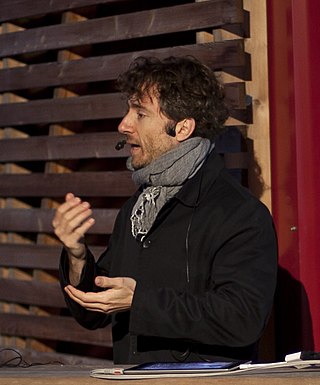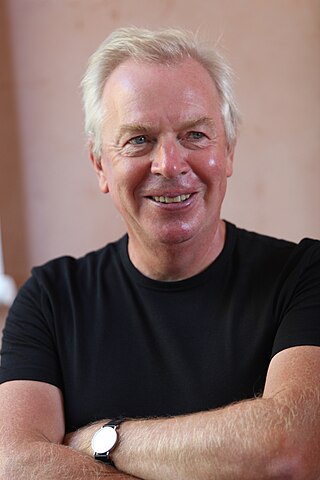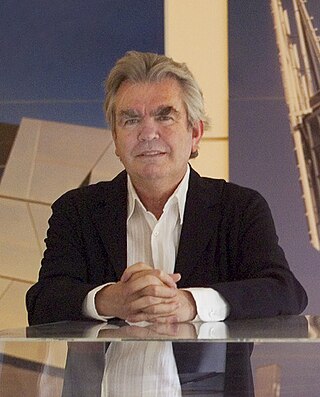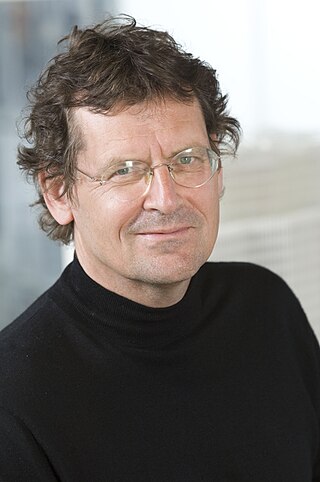Related Research Articles

The Royal Institute of British Architects (RIBA) is a professional body for architects primarily in the United Kingdom, but also internationally, founded for the advancement of architecture under its royal charter granted in 1837, three supplemental charters and a new charter granted in 1971.

Thomas Alexander Heatherwick, is an English designer and the founder of London-based design practice Heatherwick Studio. He works with a team of more than 200 architects, designers and artisans from a studio and workshop in King's Cross, London.
Sir Terence Orby Conran was an English designer, restaurateur, retailer and writer. He founded the Design Museum in Shad Thames, London in 1989 The British designer Thomas Heatherwick said that Conran "moved Britain forward to make it an influence around the world." Edward Barber, from the British design team Barber & Osgerby, described Conran as "the most passionate man in Britain when it comes to design, and his central idea has always been 'Design is there to improve your life.'" The satirist Craig Brown once joked that before Conran "there were no chairs and no France."

Sir David Alan Chipperfield, is a British architect. He established David Chipperfield Architects in 1985, which grew into a global architectural practice with offices in London, Berlin, Milan, and Shanghai.

Allies and Morrison LLP is an architecture and urban planning practice based in London and Cambridge. Founded in 1984, the practice is now one of Britain's largest architectural firms. The practice's work ranges from architecture and interior design to conservation and renovation of historic buildings to urbanism, planning, consultation and research. The firm's notable projects include the redevelopment of the Royal Festival Hall, the masterplan for the Queen Elizabeth Olympic Park, BBC Media Village and the redevelopment of King's Cross Central. The practice has a reputation for designing modernist, yet stylistically restrained buildings.
Glenn Paul Howells is a British architect and a director and founder of Glenn Howells Architects.

Associated Architects is a leading AJ100 architectural firm with offices in Birmingham and Leeds, England. Founded in 1968, the practice has a broad portfolio of work including arts, commercial offices, residential, masterplanning and leisure and is particularly known for its work in education. It has received many national awards including over 30 RIBA Awards, together with the RIBA Sustainability Award. For its commercial work it has been awarded 9 BCO Awards, British Council for Offices. The practice designed the George Davies Centre, at the University of Leicester, currently the largest (non-domestic) building in the UK to be Passivhaus accredited. It is also responsible for the design and delivery of Bartholomew Barn, the UK's first "multi-comfort" building, a benchmark pioneered by Saint Gobain. The building has set a new bar for sustainable architecture.

Leopold Square is a mixed-use development in Sheffield's West End, England, located at the corner of Leopold Street and West Street. The development, by Ask Developments and Gleeson's in collaboration with local architects AXIS Architecture, comprises the refurbishment of the former Central Technical School buildings, built between 1870 and 1894, into apartments, bars, restaurants and a hotel. The development also has a new angular building to house a bar and a restaurant, and the creation of a brand new public square. The redevelopment of the old buildings began in 2004, following years of use as council offices after the closure of the Schools.
Pringle Richards Sharratt is an architectural firm that was formed in 1996 by John Pringle, Penny Richards and Ian Sharratt. Based in London, the practice has worked on public buildings, art galleries, museums, libraries, archives, university and transport buildings. Before forming PRS, John Pringle and Ian Sharratt were partners at Michael Hopkins and Partners and Penny Richards had her own practice that specialised in museum and gallery projects.

Lifschutz Davidson Sandilands is a practice of architects, urban designers and masterplanners established in 1986 and practising out of London.
Grimshaw Architects is an architectural firm based in London. Founded in 1980 by Nicholas Grimshaw, the firm was one of the pioneers of high-tech architecture. In particular, they are known for their design of transport projects including Amsterdam Bijlmer ArenA railway station, Waterloo International railway station and the award-winning Southern Cross railway station which was the recipient of the Royal Institute of British Architects Lubetkin Prize. Grimshaw is behind the design of the Sustainability Pavilion, an innovative net-zero building, for Expo 2020. The firm currently has offices in Los Angeles, New York, London, Paris, Dubai, Melbourne and Sydney, employing over 600 staff.

John Renwick McAslan is a British architect.

Feilden Clegg Bradley Studios is a British architectural design firm, established in 1978, with offices in Bath, London, Manchester and Belfast. The firm is known for its pioneering work in sustainable design and social design agenda.

Sir Terence Farrell, known as Terry Farrell, is a British architect and urban designer. In 1980, after working for 15 years in partnership with Sir Nicholas Grimshaw, Farrell founded his own firm, Farrells. He garnered a strong reputation for contextual urban design schemes, as well as exuberant works of postmodernism such as the MI6 Building. In 1991, his practice expanded internationally, opening an office in Hong Kong. In Asia his firm designed KK100 in Shenzhen, the tallest building ever designed by a British architect, as well as Guangzhou South railway station, once the largest railway station in Asia.

Eric Owen Parry is a British architect, designer, writer and educator. Parry is the founder and principal of Eric Parry Architects established in London in 1983. His built work includes the restoration and renewal of St Martin-in-the-Fields in London, the Holburne Museum in Bath, 50 New Bond Street, 23 Savile Row, One Eagle Place in Piccadilly, Aldermanbury Square by London Wall, 30 Finsbury Square in London, and the London Stock Exchange. His projects also include a number of residential developments. Eric Parry's architectural work and design has been shown internationally on major exhibitions, including the Royal Academy of Arts, the British School at Rome, and the 2012 Venice Biennale of Architecture.
Professor Jeremy Till is a British architect, educator and writer. He is Professor of Architecture at Central Saint Martins, University of the Arts London. He was Head of Central Saint Martins and Pro Vice-Chancellor of the University of the Arts London from 2012 to 2022.
Sadie Anna Morgan is an English designer. In 1995 she founded dRMM, the RIBA Stirling Prize winning architecture practice, with Alex de Rijke and Philip Marsh.
The London School of Architecture, known as the LSA, is a small independent higher education provider based in London. It is England's first independent school of architecture since the Architectural Association opened in 1847.
RIBA National Awards are part of an awards program operated by the Royal Institute of British Architects, also encompassing the Stirling Prize, the European Award and the International Award. The National Awards are given to buildings in the UK which are "recognised as significant contributions to architecture" which are chosen from the buildings to receive an RIBA Regional award.
Dr. Harriet Harriss, is a UK-licensed architect, writer, and historian, and served as the Dean of the Pratt School of Architecture in Brooklyn, New York from 2019-2022. Prior to this, she led the Architecture Research Program at the Royal College of Art in London until 2015 and the Masters in Architecture Program at Oxford Brookes from 2009-2015. Her scholarship principally concerns pioneering pedagogies in architectural education and confronts themes such as feminism; equity, decolonization, diversity and inclusion; civic engagement; the climate crisis, and queer ecologies. After graduating from the Royal College of Art in 2003, Dr. Harriss established Design Heroine Architects - a participatory design practice that secured NESTA start-up funding in recognition of its social innovation objectives in 2004. Throughout her academic career, Harriet won various awards for teaching and research, including, a Diawa Foundation Fellowship, two Santander Awards, a Brookes Teaching Fellowship, a Winston Churchill Fellowship, and a HEA Internationalisation fellowship. In 2016, Dr. Harriss was awarded a Clore Fellowship for cultural leadership, elected to the European Association of Architectural Education Council (EAAE) in summer 2017, and in 2018, awarded a Principal Fellowship of the UK's Higher Education Academy. Harriet's consultancy roles include the UK Department for Education construction industry T-Level panel, international program validations, external examining, and pedagogy design and development. From 2018-2020, Dr. Harriet Harriss chaired the RIBA's prestigious Dissertation Medal judging panel and in 2016, secured a 500k Euro research grant from Erasmus to lead an international consortium investigating the trans-sector applications of an architecture degree. Dr. Harriss has spoken across a wide range of media channels on the wider issues facing the built environment. Dr. Harriss is also recognized as an advocate for diversity and inclusion within design education and was nominated by Dezeen as a champion for women in architecture and design in 2019. Her books include Architecture Live Projects: pedagogy into practice (2015), Radical Pedagogies: Architectural Education & the British Tradition (2015), A Gendered Profession (2016), Interior Futures (2019), Architects After Architecture (2020), Greta Magnusson Grossman: Modern Design From Sweden To CaliforniaArchived 28 October 2020 at the Wayback Machine (2020). Her forthcoming books include Architectural Pedagogies of the Global SouthArchived 1 December 2020 at the Wayback Machine (2021), The Architecture of the Post-Anthropocene (2022).
References
- ↑ Soane, James (2003). New Home. Conran Octopus. ISBN 978-1-84091-283-8.
- ↑ "London winners 2010". Architecture.com. 20 May 2010. Retrieved 28 December 2013.
- ↑ "Award Winning Homes". British Homes Awards. Retrieved 28 December 2013.
- ↑ RIBA Awards
- ↑ RIBA Awards